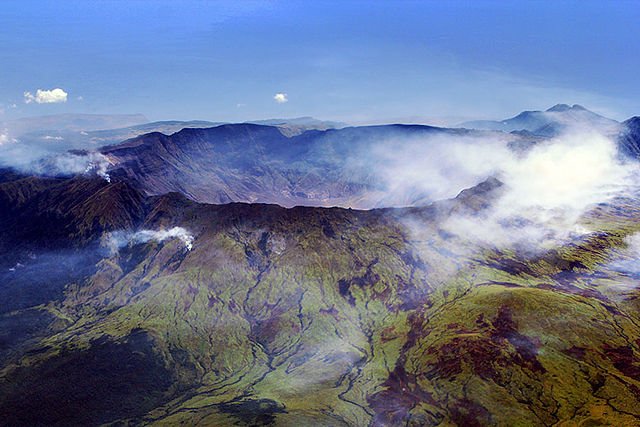A new study published in Nature demonstrates that early humans on the coast of South Africa survived through the eruption of a supervolcano.
To give a sense of the size of the supervolcano eruption that early South Africans managed to survive through, a separate eruption of Mount Tambora in 1815 Indonesia caused an entire year without summer, with massive crop failures across Eurasia and North America accompanied by famine and mass migrations. The effects of the supervolcano that erupted around 74000 years ago – Mount Toba – would have caused impacts that were far greater than we’ve ever experienced as modern day humans.
However, despite the Mount Toba eruption, humans in South Africa managed to thrive. Perhaps most devastating about a supervolcano eruption of that size is the ash-fall. Huge quantities of the ash injected high into the atmosphere would have severely diminished sunlight – with some estimates suggesting there was a reduction of up to 90%. There has been evidence of significant changes in the environment in East Africa following the eruption of the Toba supervolcano, but early modern humans somehow managed to continue business as usual.
Panagiotis Karkansas, the director of the Malcolm H. Wiener Laboratory for Archaeological Science, American School of Classical Studies, Greece, saw a single shard of the Mount Toba supervolcano eruption when looking under a microscope at a slide of sediment encased in resin.
“It was one shard particle out of millions of other mineral particles that I was investigating. But it was there, and it couldn’t be anything else,” says Karkanas in a press release.
“Takis and I had discussed the potential of finding the Toba shards in the sediments of our archaeological site, and with his eagle eye, he found one,” explains Curtis W. Marean, the associate director of the Institute of Human origins At Arizona State University, honorary professor at the Centre for Coastal Palaeoscience at Nelson Mandela University, South Africa, and project director of the Pinnacle Point excavations that turned up this new information.
The tiny volcanic shard that the research team managed to find was analyzed and traced back to the killer supervolcano eruption from Mount Toba. This finding is significant, because it provides one of the first pieces of evidence that connects humanity to this devastating explosion.
“Many previous studies have tried to test the hypothesis that Toba devastated human populations,” Marean notes. “But they have failed because they have been unable to present definitive evidence linking a human occupation to the exact moment of the event.”
Erich Fisher, an associate research scientist with the Institute of Human Origins who was responsible for building detailed photorealistic 3D models from the supervolcano data stated that “What we found was that during and after the time of the Toba eruption people lived at the site continuously, and there was no evidence that it impacted their daily lives.”
Outside of giving us further insight into how the eruption of the Toba supervolcano affected humanity in the region, the study also has brought about some important advancements in the field of archaeological dating techniques. With data that is this old, it’s possible that there could be a dating error of around 10 percent. This may not seem like a lot, but with samples as ancient as the one studied with the Toba supervolcano, it can be an error of thousands of years. However, the dating of Mount Toba was well-understood beforehand which allowed archaeologists to provide a more exact window, with the shard deposition likely happening within two weeks.
“We found the shards at two sites,” explains Marean. “The Pinnacle Point rockshelter (where people lived, ate, worked and slept) and an open air site about 10 kilometers away called Vleesbaai. This latter site is where a group of people, possibly members of the same group as those at Pinnacle Point, sat in a small circle and made stone tools. Finding the shards at both sites allows us to link these two records at almost the same moment in time.”
The eruption of the Mount Toba supervolcano has been discussed at great length by scientists since the 1990s, with many arguing that it caused a long-lived volcanic winter that could have devastated the world’s ecosystems and caused a near-extinction event in the evolution of humanity. The results of this data show that – at least in the food-rich area of southern Africa – people managed to thrive through this devastating event.
Moving forward, teams can take the research methods that were developed in this study and apply them elsewhere in Africa in order to understand whether the survival of early South Africans was unique or more widespread throughout the continent.





